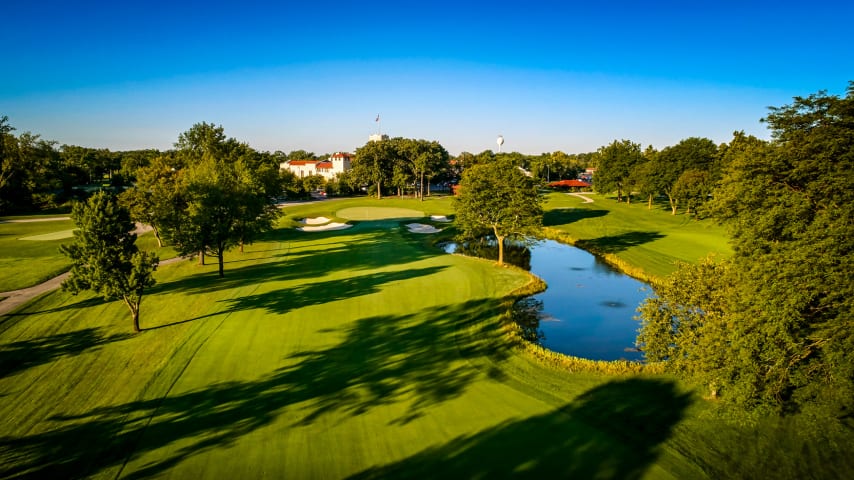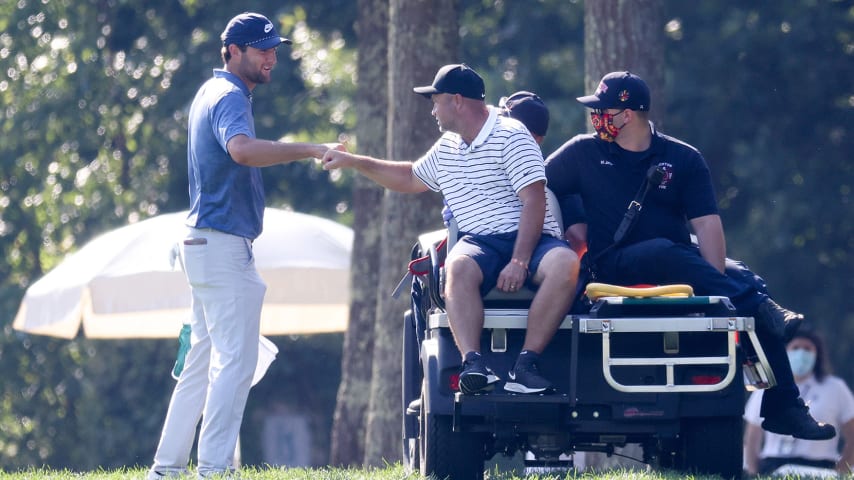Nine things to know: Olympia Fields
9 Min Read

Written by Mike McAllister

The FedExCup Playoffs are back
It’s been 17 years since Olympia Fields last hosted an event on the PGA TOUR schedule. The Chicago gem was the site of the 2003 U.S. Open won by Jim Furyk, and a small handful of players in that field that week -- including Tiger Woods -- will make a return visit at this week’s BMW Championship.
RELATED: FedExCup standings | The First Look
Other players have more recent familiarity with the course, thanks to the 2015 U.S. Amateur won by Bryson DeChambeau, who entered the FedExCup Playoffs inside the top 10 in the FedExCup standings. So did Collin Morikawa and Jon Rahm, two others who played at Olympia Fields five years ago.
In looking for one word to describe Olympia Fields, “big” likely would be the first choice. But maybe that word isn’t strong enough. As golf historian Herbert Warren Wind once wrote, “Bigger and better went up all over the country. But Olympia Fields was the daddy of them all.”
To get you acquainted with Olympia Fields, here are nine things to know:
1. Four courses
Olympia Fields founder Charles Beach had plenty of land on which to build his new private golf club. So much land – nearly 700 acres – that 18 holes would look lost on the property. As would 36 holes. And 54 holes. Thus, Beach decided to make Olympia Fields the first private club in America to offer its members 72 distinctive holes spread over four courses.
The first course, designed by Tom Bendelow, opened in 1916. Two years later, another course opened, this one designed by William Watson. Bendelow and Watson collaborated on the third course, opened in 1920. Then came the big finish – a course along the northern edge of the property designed by famed Scottish golf architect Willie Park Jr. opened in 1922. It’s Park’s North Course that hosts this week’s BMW Championship.
“He was first hired in 1919 by the club to review and modify the first three courses, concentrating on No. 3,” wrote Tim Cronin, author of “Golf Under the Clock Tower.” “Park spent four days and came up with improvements for all three. The minutes aren’t specific but the presumption is that the board like his work so much, they hired him for No. 4.”
Park, a two-time Open champion, eventually spent 40 days on property to oversee Olympia Fields’ signature course. It was one of his last designs – and one of his best. “I am satisfied now that your Number IV Course is the equal of any golf course I have ever seen,” Park once wrote, “and I know of none that is superior, either in beauty or natural terrain.”
The four courses not only offered members plenty of variety, it also created a unique challenge. On Sept. 27, 1938, J. Smith Ferebee reportedly played all four courses … twice. No word on his score for the 144 holes that day.
After World War II, Olympia Fields faced some economic hardships and sold off half of its land, keeping the No. 4 course intact while creating a composite South course from holes used on the other three courses.
Despite the reduction to 36 holes, the clubhouse grill retains its original name: the 73rd Hole.
2. Huge clubhouse
Chicago architect George Croll Nimmons excelled in big buildings. In 1904, he and partner William Fellows were selected to design a new warehouse and distribution center for Sears, Roebuck and Co. on the city’s West Side. In just 12 months, the project was completed, with nearly a million square feet of floor space, along with an office building that extended half a block. It was considered the “largest mercantile plant in the world” as well as the biggest architectural project in Chicago to that point.
So it’s no surprise that when Nimmons received the commission to design the clubhouse to service Olympia Fields’s four courses two decades later, he had big plans. The result? An 110,000 square foot clubhouse – the largest private golf clubhouse in the world (a more recent reference put the square footage closer to 200,000). A dining room that could seat 800; a café that could seat 600. A 22,000 square foot men’s locker room. The clubhouse even had its own hospital and fire station. The cost? Approximately $1.3 million. Sounds quaint today, but a significant total back then.
After two years of construction, the clubhouse officially opened with a dedication ceremony and banquet on May 16, 1925. Although a steady drizzle impacted the golfers that afternoon, it didn’t dampen the festivities. Three dance bands played that night, with nearly 1,400 in attendance. “There was a dinner and guests made merry,” wrote the Chicago Tribune’s Morrow Krum, who described the clubhouse as “one of the most beautiful in the country.”
3. The clock tower
The signature element of Nimmons’ clubhouse is the 80-foot clock tower. Thanks to its four faces, each golfer was assured of seeing the clock from the No. 1 tee box on each of the four courses.
Erosion through the years eventually forced the club to commission a restoration project on the tower in 1994. The damaged stucco was removed and new stucco matching the original color of the tower was added.
4. Amos Alonzo Stagg
Golf isn’t the first sport that comes to mind when Amos Alonzo Stagg is mentioned. After all, he’s in the College Football Hall of Fame – as both a player and coach. He’s also in the Basketball Hall of Fame, among the first group of inductees in 1959. He played baseball while attending Yale; oh, and he also invented the batting cage.
He was a charter member at Olympia Fields but was more likely to be seen on the tennis courts than the fairways. Still, he did make a significant impact at the club.
He came up with the name.
Stagg was the head football coach at the University of Chicago when Charles Beach began the process of developing his new club. Stagg was then unanimously voted as the club’s first president. As for the club name, Stagg proposed “Olympia” (with “Fields” added later). In a written explanation for the name’s origin, Stagg compared the idealism of ancient Olympia to the modern-day one in Chicago.
“One represented noble ancient ideals,” Stagg wrote, “the other represents modern ideas meeting physical ideas in a pleasurable way.”
5. Tents to Cottages
Early members at Olympia Fields certainly were fired up to play golf. One took it to the extreme – he camped out overnight in a tent among the oak trees at the club one weekend. Soon, others joined him and eventually, the canvas tents grew to 31.
The club decided to offer more permanent structures. By 1925, all the tents were gone and 65 cottages became available for overnight stays.
6. First tournament program
In the 1928 U.S. Open at Olympia Fields, Bobby Jones was seeking his third U.S. Open title but was denied by Johnny Farrell in a 36-hole playoff – the first year the organization had used that tiebreaker format. Evidently, USGA officials didn’t leave with a favorable impression, as it took 75 years before Olympia Fields hosted another U.S. Open.
Still, there was at least one lasting hook – the creation of the tournament program. Celebrated Chicago sportswriter Herb Graffis, who had launched two golf publications with his brother Joe earlier in the decade, developed and produce the first Open program for his hometown Open.
According to Graffis’ 1975 book, “The PGA,” the Olympia Fields program was immensely popular, generating nearly as much money as the ticket sales. As for Graffis, he was inducted into the World Golf Hall of Fame, his biography referencing his approach toward golf literature: “The most important guy was the one reading it, not the guy who was being written about.”
7. Western Open
The BMW Championship was formerly known as the Western Open, the legendary tournament created by the Western Golf Association in 1899. Olympia Fields has hosted the tournament five times:
• 1920, won by Jock Hutchinson.
• 1927, won by Walter Hagen.
• 1933, won by Macdonald Smith.
• 1968, won by Jack Nicklaus.
• 1971, won by Bruce Crampton.
Nicklaus’ win ended a 1968 drought that started with 16 consecutive starts without a victory – an eternity for the Golden Bear back then.
“I was hoping I wasn’t going to get through the year without a victory,” Nicklaus said after his win. “And I’m glad it happened on such a nice golf course. A player likes to win any tournament, certainly, but you’re prouder to win, I guess, on a real good course.”
8. Major credentials
Olympia Fields has hosted two U.S. Opens (1928, 2003) and two PGA Championships (1925 with match play; 1961 with stroke play). It’s also hosted a U.S. Senior Open (1997) and an U.S. Amateur (2015). Less than 10 courses in the country have hosted all four of those events.
In the week leading up to the 1925 PGA, Gene Sarazen inquired about buying Olympia Fields. Saying he represented a Wall Street syndicate that wanted to turn the club into a public course, Sarazen offered $3 million. When that was turned down, he offered $3.5 million.
“During the last two months, Olympia Fields has turned down two offers of $4 million for the property and clubhouse,” a club official told the Chicago Tribune.
In the years after the 2003 U.S. Open, conditions on the North Course’s greens deteriorated. When Sam MacKenzie arrived in 2006 as Director of Grounds, he immediately began to solve the issues.
“I set about creating a maintenance regimen that emphasized sound turf management practices to repair the turf and restore the golf course,” MacKenzie told Golf Course Magazine. “I think it is safe to say we restored more than turf that first summer — we restored confidence in the grounds department as well.”
Less than 10 years later – and on its 100th anniversary -- Olympia Fields hosted the U.S. Amateur won by DeChambeau. Its most recent major was the 2017 Women’s PGA Championship, won by Danielle Kang.
9. An all-timer from Tiger
Tiger Woods has struck 5,453 shots in his U.S. Open career. Arguably, the most impressive of those shots came at Olympia Fields.
It was the second round in 2003 at the par-5 sixth. Woods had pushed his drive right, leaving him approximately 250 yards from a pin that was blocked by trees.
Instead of laying up, Woods opted to hit a cut 3-wood around the trees. With the ball in the air, TV analyst Roger Maltbie said, “That’s not a cut. That’s a slice.”
Either way, Woods had hit the perfect shot, his ball finishing 15 feet from the hole to set up a two-putt birdie. It didn’t win him the tournament – he faded on the weekend, finishing T-20 – but it remains a testament to his incredible skills during his heyday.
“It’s the same shot I hit in practice,” Woods explained afterwards. “I put the ball in the first cut of rough and I said, ‘Well, it’s the same shot. Go ahead and do it. Go ahead and trust it.’”
One of his playing partners that day, Ricky Barnes, said it was the greatest shot he had ever seen Woods hit. “It was unbelievable power,” Barnes told Golf magazine, “and to cut it that much. We just nodded, ‘Great shot.’ He looked like he’d just hit a home run.”






